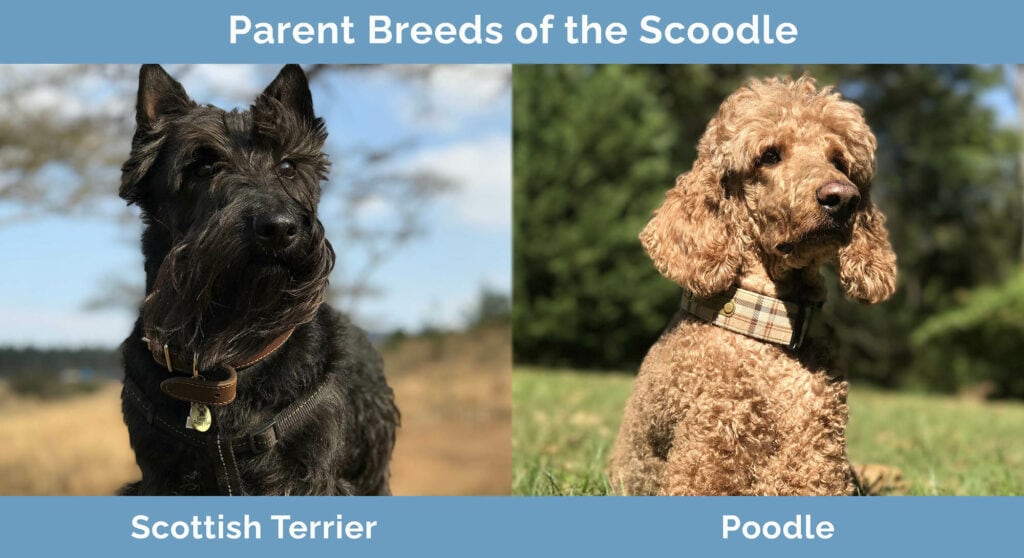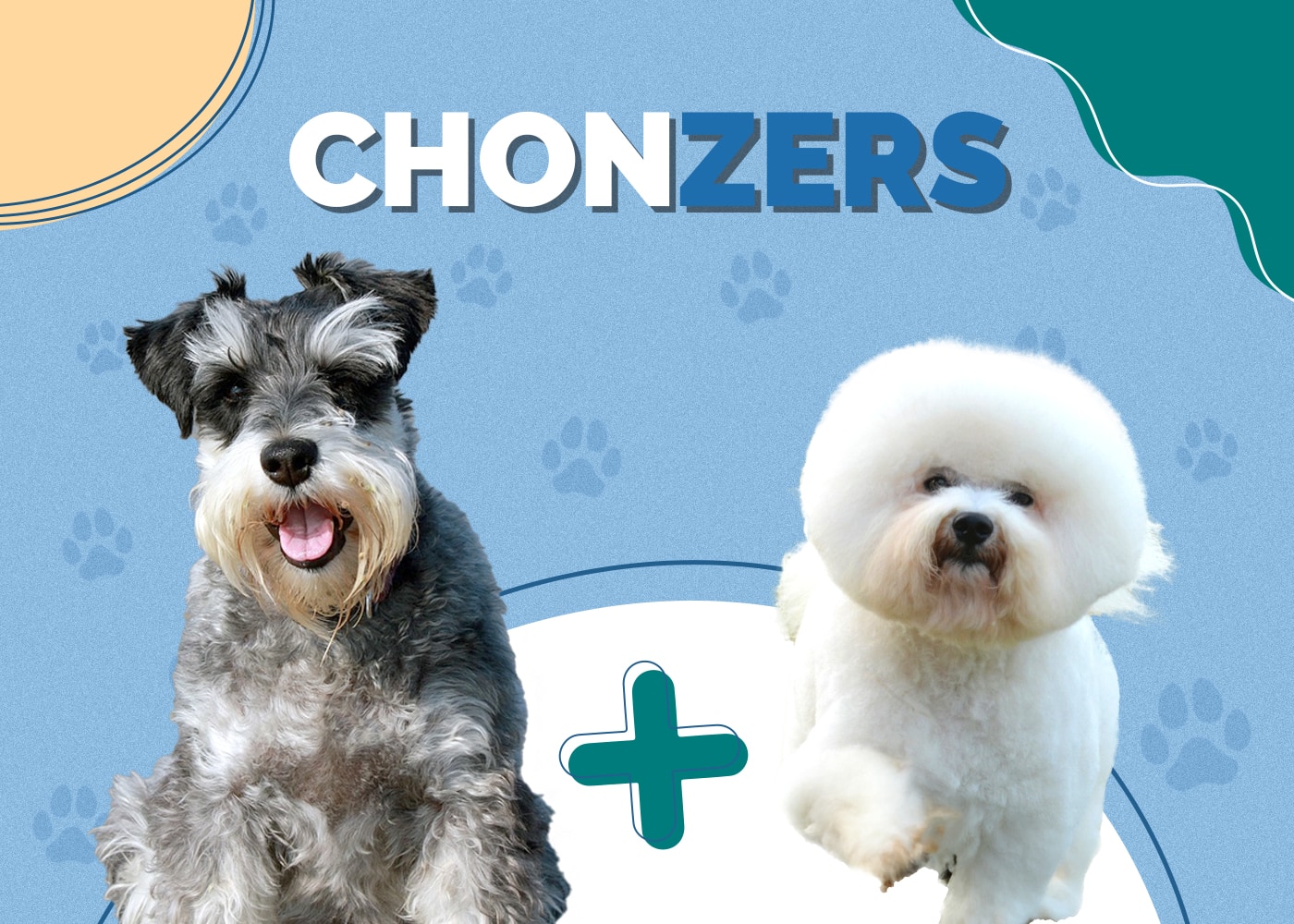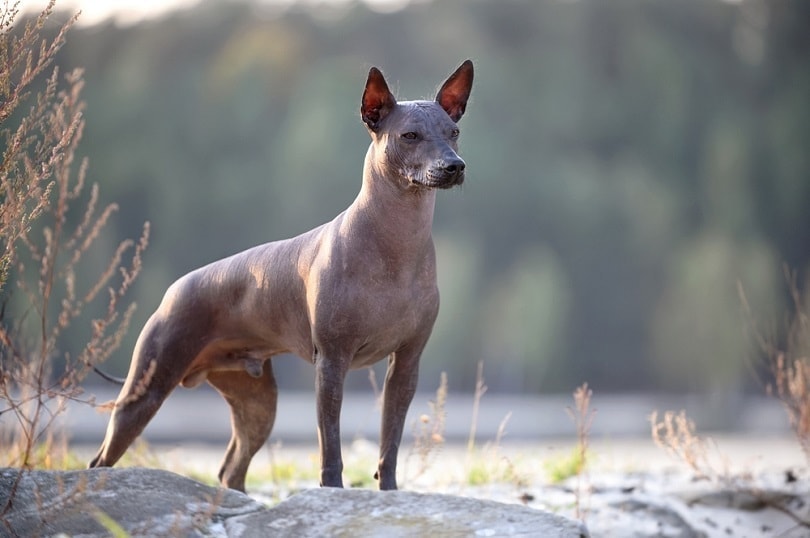Scoodle (Poodle & Scottish Terrier Mix): Info, Pictures, Characteristics & Facts

Updated on

Height:
7 – 12 inches
Weight:
9 – 20 pounds
Lifespan:
12 – 15 years
Colors:
Black, gray, brown, white, silver
Suitable for:
Active families, those looking for a low-shedding dog
Temperament:
Loyal, affectionate, protective, aloof with strangers, intelligent
There are hundreds of dog breeds out there for you to choose from. The Scoodle is a newer mix between a Scottish Terrier and a Poodle. While these two breeds have likely been cross-breeding for a while, breeders are only recently crossing them on purpose to create these adorable canines.
Mixed breeds like the Scoodle are not as “set-in-stone” as purebreds. When you mix two breeds, you never know what traits the puppies are going to inherit. Because of this, the Scoodle varies quite widely.
Still, there are some common traits every Scoodle shares. In this article, we’ll go over what you can expect from these tiny dogs and whether one would fit in nicely with your lifestyle.
Scoodle Puppies
Some Scoodles look precisely like a Poodle. Others look like Scottish Terriers. Most, though, look like something in the middle.
Their fur may be straight and silky or curly and wiry (or anything in between for that matter). You really won’t be able to tell a particular dog’s coat type until they are grown up. Some of them shed lots, while others don’t shed at all!
These dogs often have quite a bit of energy. Poodles were built for all-day swimming and are very energetic. Their puppies often inherit these same traits – at least to some extent.
While these dogs are very smart, they can also be somewhat stubborn. Many owners describe them as being too smart for their own good. Because of this, they need a strong, affectionate leader. They are not good choices for first-time owners simply because of their intelligence level.
As they are a mixed breed, they tend to be healthier than their purebred counterparts. While they are prone to some health problems, they usually do not experience as many health problems as their parents.
These dogs can be a bit protective. They are very fond of their people, but may be aloof with strangers. Early socialization is required to ensure their protective instincts don’t get the best of them.
3 Little-Known Facts about the Scoodle
1. They aren’t necessarily hypoallergenic.
Because these dogs are mixed with a Poodle, many people assume they’re hypoallergenic. However, this is not necessarily the case.
Firstly, there is no truly hypoallergenic dog. People with dog allergies are allergic to a dog’s skin and saliva. While a dog’s loose hair helps carry this stuff around, every dog is going to have skin and saliva – there is no getting around that. Therefore, someone with dog allergies will be allergic to every dog, not just those that shed.
Secondly, Scoodles aren’t necessarily going to be shedding-free. Many will shed quite a bit, though some may shed very little. You have no idea until they mature and actually start shedding. If you need a non-shedding dog, a mixed breed like this probably isn’t for you.
2. They aren’t always lap dogs.
Because of their smaller size, many people assume that these dogs like to cuddle. However, that isn’t necessarily the case. While some do like to cuddle, of course, others prefer to be left alone.
Many owners describe these dogs as “dignified” – and they fit that descriptor quite well!
3. They’re very smart.
Poodles are extremely smart, so there is a chance their offspring will inherit their genius.
Many owners think having an intelligent dog will be great. However, they are often more work than potential owners realize. These dogs need mental stimulation, which will require more work on your part. They require quite a bit of extra time.

Temperament & Intelligence of the Scoodle 🧠
The temperament of a Scoodle is also hard to predict. It depends on what traits they inherit from their parents, as well as their upbringing. Dogs that were socialized intensely as puppies are almost always going to be gentler and friendlier than dogs who were not.
Still, this breed is likely to have some common traits.
They will likely be quite affectionate and bond closely with members of their family. Some might be “one person” dogs, which means that they’ll only bond closely with their person.
These dogs can suffer from separation anxiety, which can cause destructive behavior. This is something you’ll have to work with your dog on. Training can help alleviate the symptoms of separation anxiety, but it can be quite a lot of work. Early crate training can be helpful to prevent separation anxiety from forming as the dog ages.
Many of these dogs are loyal and may be a bit protective. Socialization is necessary to prevent aggression.
Luckily, these dogs are also quite intelligent. They quickly take to training, though they can be a bit stubborn. Having a healthy relationship is your best bet for guaranteeing that a Scoodle will listen to your commands.
Most of the time, the Scoodle is not the friendliest dog in the world. They tend to be a bit untrusting with strangers. That doesn’t necessarily mean they are aggressive, but they prefer to keep their distance. Over time, though, they will warm up.
Are These Dogs Good for Families? 🏡
These dogs usually do fine with children as long as they are introduced to them early in life. However, they are typically a bit “dignified” and dislike rough play. They should be supervised with children at all times, especially younger kids who can’t always be trusted to be gentle.
Sometimes, Scoodles can be one-person dogs. Simply put, this means that they tend to bond very strongly with one person. In some families, this can be a problem. However, other families don’t particularly mind this dynamic.
If you want a dog that is going to bond heavily with your children, this is probably not the right dog for you.
Does This Breed Get Along with Other Pets? 🐶 😽
Similarly, the Scoodle is not always readily accepting of other dogs. They take a bit to warm up and will not tolerate other dogs getting in their face. You may need to keep them separate from your other animals for a bit until they have adjusted.
They do not have particularly high prey instincts, so they are usually fine with cats and smaller animals. Of course, socialization is important. They can be a bit protective and take a bit of time to warm up to other dogs.
However, they are not as territorial as some other dogs. They can get along with some other canines, but it may require a bit of time.
Things to Know When Owning a Scoodle
Food and Diet Requirements 🦴
These dogs are only medium size. However, they are quite a bit active. Because of this, they may require quite a bit more food than you might imagine. Of course, it is also essential that they get all the nutrients they need. They do not have any particular nutritional needs, though. They need about the same vitamins and minerals as other breeds.
Still, it is essential to following the feeding guidelines on the back of whatever food you’re feeding them. These dogs are not particularly prone to being overweight. But that doesn’t mean it can’t happen. Being overweight is associated with a large variety of health consequences, so it is important to keep your pooch at a healthy weight.
They are somewhat prone to bloat, so you should feed them at least twice a day. We will discuss this condition more in the health section below.
A proper macronutrient content of the food is essential. Studies have shown that dogs need a diet of approximately 30% protein, 63% fat, and 7% carbohydrates. It is very difficult to find a food that fits this nutritional ratio. However, choosing a food that is high in protein and fat, while low in carbohydrates, should be suitable.
Exercise 🐕
These medium-sized dogs need quite a bit of exercise. The Poodle was bred to work all day in an intense setting, and this mixed breed often inherits this.
They are often active and quite energetic. Daily exercise is necessary to keep these dogs healthy and behaved. A long daily walk is your best bet, though your pooch may also need extra playtime in the backyard as well. Plan to walk a dozen miles a week and exercise your dog for about an hour each day.
Because these dogs are intelligent, they also need some degree of mental stimulation each day. This stimulation can be achieved through training, puzzle toys, or games like hide-and-seek.
These dogs do best in active families. If you get them outside enough, they will do fine in an apartment.
Training 🦮
These dogs are very smart. Because of this, they can learn basically any command you can think of.
However, their intelligence means that they can also be extremely stubborn. They are smart enough to get out of punishments and figure out how to get what they want (without necessarily listening to you).
They also require quite a bit of mental stimulation. Training can fulfill this niche. However, you can also use puzzle toys and games like hide-in-seek.
Grooming ✂️
These dogs may not shed very much, or they may shed a lot. It depends on which parent they inherit their coat from. Poodles don’t shed very much at all, so there is a possibility that Scoodles may not either.
The grooming routine the Scoodle needs depends on their coat type. In almost every case, weekly brushing will be needed at the very least. Dogs with particularly long coats may need to be brushed even more to prevent tangles.
They may also need regular trimming, like their Poodle parent.
Like all dogs, you will need to take proper care of their nails and teeth. Your groomer can clip their nails for you, or you can do it yourself. You should brush their teeth daily.
Baths are not necessary unless your pooch gets dirty. If you visit the groomers regularly, your dog will get plenty of baths there.
Health and Conditions ❤️
Like all breeds, the Scoodle may be prone to a few health problems.
In general, mixed breeds are much healthier than their purebred counterparts. This is simply because they inherit a wider variety of genes, which prevents them from sharing many of the common genetic disorders their parents may have.
In other words, mixed breeds come from a larger gene pool, making them healthier.
However, that doesn’t mean mixed breeds are entirely free from health problems. They can inherit health difficulties from either of their parents. Being aware of these problems is essential since early diagnoses are often the key to treatment.
- Skin Allergies
- Patellar Luxation
- Hip Dysplasia
- Eye Problems
- Sebaceous Adenitis
- Epilepsy
- Bloat
- Addison’s Disease
- Cushing’s Disease
Sebaceous Adenitis
Sebaceous adenitis is somewhat familiar in Poodles, making the Scoodle prone to it as well. This disorder is purely genetic and is a recessive gene according to the latest research. However, not all dogs with the gene to express this disease will end up developing it over their lifetime. It appears the environment also plays a role.
To put it simply, this disease is characterized by the inflammation of the sebaceous glands. These glands produce oils that keep your dog’s skin moist and healthy. They are located in every hair follicle. Oil is produced, and then it pushes through the follicle onto your pet’s skin.
When these glands are inflamed, it destroys them. Without the glands, your pet’s skin no longer produces oil. This is a problem.
Treatment involves treating the inflammation and replacing the oil your dog is no longer able to produce.
Epilepsy
This is a common neurological condition in dogs. It affects about 0.75% of all dogs. This disorder is characterized by returning, unprovoked seizures. It can be inherited and is genetic, though some cases are due to non-genetic abnormalities.
Treatment almost always involves medications of some sort.
Bloat
Bloat is a bit of an enigma in the medical community. It is technically two different conditions, but both are very similar to each other.
In this condition, the dog’s stomach fills with gas. In some cases, it twists as well. Either way, the gas cannot escape the dog’s stomach for whatever reason. Eventually, this can cause serious problems (like their stomach exploding).
The Poodle is prone to this disorder, which can make the Scoodle prone to it as well.
Vets don’t know what causes this disorder. Food, ice water, too much food, too much exercise, too many carbohydrates, and a plethora of other causes have been proposed, but none of them have been proven.
Gulping food and only feeding your dog once during the day have both been associated with bloat. Giving your dog a puzzle feeder to slow them down and splitting their meals up are both suitable ways to prevent bloat.
Addison’s Disease
This disease involves the adrenal glands, which sit on top of the kidneys. These glands stop producing enough cortisol and aldosterone for whatever reason.
Your dog needs both of these hormones to function correctly.
The symptoms of Addison’s disease are vague and often seemingly random. Your dog might show symptoms like lethargy, increased thirst, increased urination, and diarrhea. The symptoms may come and go.
Cushing’s Disease
Cushing’s disease occurs when your dog produces too much cortisol. About 80% of all cases are triggered by a tumor on the pituitary gland, which sits at the base of the brain. In the other 20% of cases, a tumor on the adrenal gland causes the overproduction.
Symptoms include increased thirst, increased urination, increased appetite, reduced activity, panting, thin skin, hair loss, and recurrent skin infections.
In many cases, the affected canine is treated with medication. To cure this disorder, the tumor needs to be removed. However, this is often riskier than just prescribing medication to counteract the problem.
Treatment is often a balancing act that requires monitoring and frequent blood tests. The dosage of the medication will need to be adjusted regularly. However, most dogs live full and happy lives.
Males vs. Females
There is not a significant difference between males and females in this breed. They’re about the same weight and height no matter their sex.
Their personalities are also extremely similar.
Final Thoughts
Scoodles can make great medium-sized dogs for active individuals. They can get along well in a family as long as they are socialized early. They are not particularly fond of young children, though, so only families with older individuals would be best.
They’re extremely smart and active, requiring quite a bit of time and upkeep. However, for those who can commit the time, they can be very affectionate and loyal.
See Also:
- Scotchi (Scottish Terrier Chihuahua Mix): Pictures, Care Guide, Temperament & Traits
- Westiepoo (Westie & Poodle Mix): Info, Pictures, Characteristics & Facts
Featured Image Credit: Gary Pardy, Shutterstock












